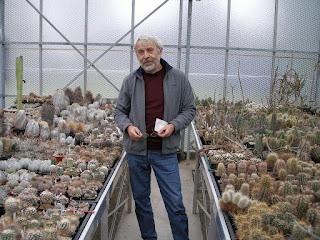Mein Vater hatte irgendwann mal diese Vita verfasst, die ich auf seinem PC gefunden habe. Ich weiß nicht wofür diese ursprünglich gedacht war aber ich möchte diesen Text gerne mit euch teilen :)
"The first
time I came across with cacti and other succulents was as a young student in
the early sixties of the last century sitting with toothache in the waiting
room of a dentist. Those plants on the window-sill were so fascinating for me,
that I nearly forgot my pain.
Two years
later the dentist became my father-in-law. No, I haven’t married his plants – I
married his daughter, Brigitte, but love
to both is still going on. My collection started with one Echinocactus grusonii,
one Cereus forbesii and one Espostoa lanata.
Meanwhile it’s a bit more. The collection grew and soon after a small
cold frame the first greenhouse (12 m²) was built up. Since that
time we selected our living place depending on the size of the next greenhouse.
We enjoyed
not only the beauty of the plants, we were also interested in their history,
how and why they have been named. Thus we started collecting and studying old
and newer literature about these plants. Pretty quickly I realized, that many
of the old and new descriptions were
rather short and superficial, or based on just a few plants, not taking into
account the natural variability of a population. Therefore quickly matured the
plan to study the plants in their natural environments. In 1976 we started our
first trip to South America , to Argentina.
It was
not the best idea, because just at that
time were heavy conflicts between the Military government and revolting youth
in Argentina. And a young couple from Europe – the man wearing long hair and a
beard – is suspicious. Controls at each corner, in each little village.
Sometimes we were surrounded by soldiers or police in the mountains in the
middle of nowhere, asking what we were doing. Fortunately we had a paper from
the University of Cologne, translated into Spanish language by the Argentinean
embassy, explaining our intention , studying “tunas” (all small cacti are
called tunas in the mountains). For normal people it’s an eatable weed. With a
smile we got back the paper and we could continue our exploration.
Several others
followed this first trip, some to South America again, some to Mexico. We could
even discover some new species, subspecies and varieties and even one new
genus. Yavia. We gave lectures in Germany and Europe between
Manchester(England) and Donetsk (Ukraine), between Kopenhagen (Denmark) and
Siena (Italy) and met a lot of friends. The seeds, which we collected were
given to friends or sold to other cactus collectors.
In 1980 we
settled in Düren and built up new greenhouses (about 500 m2 under glass). That was the beginning of
Kakteen-Piltz, seed supplier for many
cactus and succulent lovers. In 2005 I retired (I was teacher in my former
life) helping now my boss, Brigitte, who runs the nursery."
.JPG)
.jpg)

.jpg)
.JPG)